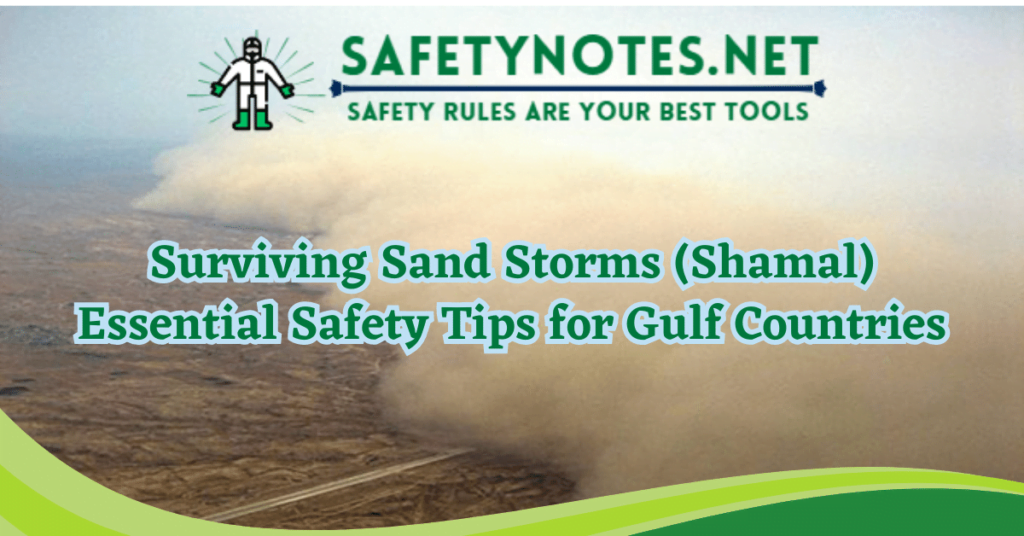
Sand storms, also known as “Shamal,” are a common occurrence in Gulf countries like Kuwait. These weather events can quickly become inclement and pose a variety of hazards to individuals. It is important for us to discuss the safety precautions and measures to be taken during sand storms to ensure the well-being of everyone involved.
Understanding Sand Storms (Shamal)
Sand storms, or Shamals, are severe weather phenomena characterized by strong winds carrying large amounts of sand and dust particles. In Gulf countries, such as Kuwait, sand storms can arise in just a few hours, transforming clear skies into a hazy environment with reduced visibility. During a sand storm, wind speeds can reach 50 to 60 miles per hour, causing potential damage and safety risks.
Driving Safety during Sand Storms
It is crucial to avoid driving into the desert or off-road areas during a sand storm. The blowing sand can reduce visibility to a dangerous level, making it difficult to navigate. When driving on roadways during a sand storm in Gulf countries, it is recommended to stay within the designated routes and not exceed a speed limit of 50 kilometers per hour. This controlled speed ensures better control over the vehicle and minimizes the risk of accidents.
Remember, always carry a pair of goggles with you when working outdoors during sand storms. Goggles provide essential eye protection from the blowing sand, preventing eye irritation and potential damage.
Taking Shelter during Sand Storms
When a sand storm strikes, it is essential to seek shelter and protect yourself from the strong winds and flying sand. If you are outdoors, immediately move indoors or find cover that shields you from the elements. This can include buildings, vehicles, or any sturdy structure that provides adequate protection. By taking shelter, you significantly reduce the risk of being exposed to the hazards of a sand storm.
Furthermore, always carry goggles with you during sand storms. Goggles not only protect your eyes while driving but also safeguard your vision when you are outside and seeking shelter.
Walking Safety during Sand Storms
Under no circumstances should you attempt to walk through a sand storm. The strong winds and flying sand particles can pose significant dangers to your safety. Instead, stay indoors or in a vehicle until the sand storm passes. Walking in such conditions can lead to disorientation, injuries, or becoming lost in the storm. It is always better to remain where you are until the weather conditions improve.
In the event that you require assistance or transportation during a sand storm, make use of radio communication to request help. This ensures your safety by allowing others to locate you and provide the necessary support without subjecting yourself to the risks associated with the sand storm.
Conclusion
Sand storms, or Shamals, in Gulf countries like Kuwait can become severe and hazardous. By understanding the characteristics and risks associated with sand storms, we can take appropriate measures to prioritize our safety. Remember to avoid driving into the desert during a sand storm, stay on roadways with reduced speed, and always carry goggles when working outdoors. During a sand storm, seek shelter, and do not attempt to walk through the storm. Utilize radio communication to request assistance or transportation when needed.
Let’s stay informed, take necessary precautions, and prioritize our safety during sand storms in Gulf countries!
Frequently Asked Questions (FAQs)
- Q: What should I do if I get caught in a sand storm while driving?
- If you find yourself caught in a sand storm while driving, it is crucial to stay calm and follow these steps:
- Reduce your speed and maintain a safe distance from other vehicles.
- Turn on your headlights and hazard lights for increased visibility.
- Pull over to a safe spot, if possible, and wait for the storm to pass.
- If you cannot find a safe place to stop, proceed with caution using the tips mentioned earlier.
- If you find yourself caught in a sand storm while driving, it is crucial to stay calm and follow these steps:
- Q: Can I wear sunglasses instead of goggles for eye protection during sand storms?
- While sunglasses can provide some level of protection against the sun, they are not designed to shield your eyes from blowing sand and dust particles during a sand storm. Goggles are specifically designed to provide a better seal around your eyes, protecting them from potential harm. Therefore, it is recommended to carry goggles for eye protection during sand storms.
- Q: How long do sand storms usually last in Gulf countries?
- The duration of sand storms can vary, ranging from a few hours to several days, depending on the intensity of the storm and local weather conditions. It is essential to monitor weather forecasts and follow the guidance of local authorities to stay updated on the duration and impact of sand storms.
- Q: Is it safe to continue outdoor activities during a sand storm?
- No, it is not safe to continue outdoor activities during a sand storm. The strong winds and blowing sand pose risks to your safety, including reduced visibility and potential health hazards. It is advisable to seek shelter indoors or in a vehicle until the sand storm subsides.
- Q: What should I do if I need assistance or transportation during a sand storm?
- In the event that you require assistance or transportation during a sand storm, it is recommended to use radio communication to request help. Reach out to the relevant authorities or your designated safety personnel to inform them about your situation and seek appropriate support. This ensures your safety while minimizing exposure to the hazards of the sand storm.
